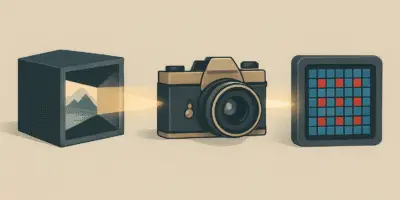Have you ever looked closely at your screen and noticed something weird? Those tiny dots of red, green, and blue somehow create every color you see – including yellow. But wait a second… how exactly does that work? If your screen only has red, green, and blue pixels, where the heck does yellow come from?
Trust me, the answer will blow your mind. Everything tech-related that you use daily – your phone, laptop, TV – is actually designed to trick a vital part of you: your visual system.
Table of Contents
The RGB Mystery
So here’s the deal: all screens use RGB (Red, Green, Blue) pixels. Not because some tech guru randomly decided it should be that way, but because your eyes literally see the world this way. Adding a yellow pixel would be completely pointless since your eyes don’t have yellow receptors to begin with.
Weird, right? There’s definitely something fishy going on here.
Let’s Get Back to Basics: How Your Eyes Work
Before diving into screens and cameras, you need to understand that all visual tech is built specifically for your eyes. So let’s start with those light sensors in your eyeballs.
Your eyes contain specialized cells called “cones” (named after their cone-like shape) that detect different wavelengths of light. You have three types of these cones, each sensitive to different wavelengths:
- One type peaks around 564 nanometers (responds most to red-ish light)
- Another peaks around 534 nanometers (responds most to green-ish light)
- The third responds best to blue wavelengths
When light hits these cones, they don’t activate in an all-or-nothing way. Instead, they respond at different intensities depending on how close the incoming light’s wavelength matches their peak sensitivity.
For example, if you’re looking at a red pomegranate reflecting light with a wavelength of 560 nanometers, your “red” cone might activate at 70% because 560nm is pretty close to its peak sensitivity of 564nm. But guess what? Your green cone might also activate at, say, 30%, and your blue cone barely at all.
Your brain receives this pattern of activation (70% red, 30% green, ~0% blue) and translates it into what you perceive as “red.” The color itself is literally created in your mind based on these activation patterns.
So What About Yellow?
This is where it gets really interesting. When you look at a lemon in real life, it reflects light with a wavelength of around 580 nanometers. This wavelength doesn’t perfectly match any of your cones, but it activates both your red and green receptors at high levels – maybe 75% red and 50% green, with blue barely responding.
Your brain receives this activation pattern and says, “Aha! This is yellow!”
But here’s the kicker: if I try to mix actual red and green light in equal proportions, I don’t get yellow. I get some weird brownish-orange color (artists, help me out with the exact name here). Even if I increase both red and green, it still doesn’t look properly yellow.
So why does mixing red and green pixels on your screen look yellow?
The Grand Deception
It’s simple but mind-blowing: your screen doesn’t actually produce real yellow light with a 580nm wavelength. Instead, it activates its red and green pixels in precisely the right proportions to create the exact same cone activation pattern in your eyes that a real yellow object would create.
In other words, your screen is bypassing the physics of color and directly manipulating the biology of your perception.
When you see a lemon on your screen, the display is sending out separate red and green light waves that trigger your cones in the same pattern as a real lemon would. Your brain, which only cares about the activation pattern (not how it was created), says “yellow” just the same.
Your brain is getting tricked. Not your eyes – your brain.
It’s All About Patterns
Here’s the thing: your brain doesn’t process colors by saying “this receptor got red, this one got green.” It processes activation patterns. We’ve evolved to recognize these patterns because they helped us interact with the natural world – identifying ripe fruits like bananas and lemons, distinguishing dangerous plants from edible ones, and so on.
We weren’t exactly evolved to look at digital screens, after all.
Yellow, orange, purple, and pretty much every color besides the pure RGB primaries are all activation patterns that your brain has learned to associate with objects in the natural world. Your screens exploit this by manipulating those same patterns, even though they’re using a completely different method to create them.
Beyond the Basics
By the way, humans aren’t the only creatures with color receptors. While we have three types of cones, certain species of mantis shrimp have 16 different types of photoreceptors that detect various wavelengths at different concentrations and processing methods. They can see ultraviolet light, our normal visible spectrum, and even infrared light!
Our three-cone system is actually not that common in nature. We’re somewhat limited in what we can see, but our brains are remarkably good at making the most of this system.
Seeing in the Dark
Humans have two main types of light receptors: cones (which we’ve talked about) and rods. The cones detect color and are what we’ve been discussing. Rods are specialized for low-light vision.
When you go outside at night, your rods take over. They’re more sensitive than cones but don’t differentiate between colors well. That’s why things look grayish in the dark – you can tell something’s there, but you can’t really make out its color. This is another example of how we evolved to interact with our natural environment rather than with screens.
The Takeaway
Sorry if I’ve ruined yellow for you! Every time you see yellow on your screen now, you might think, “That’s not really yellow – it’s a trick!” But it’s a fascinating trick, and it applies to almost all colors beyond red, green, and blue.
Your screen creates pixels that activate your photoreceptors in specific patterns so your brain translates them into colors that don’t physically exist in the display. It’s not your eyes being fooled – it’s your brain, which is wired to interpret certain activation patterns as specific colors regardless of how those patterns were created.



